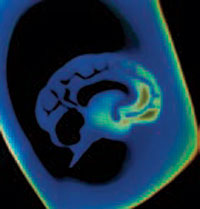
Photo: PhotoDisc
As yet, there is no way to predict the majority of cases of PD or prevent disease progression. Studies have shown that Parkinson's patients have lost 60 to 80 percent of the dopamine-producing cells in their substantia nigra before symptoms begin. Researchers don't know why or how the cells die, but they are beginning to find fascinating new clues.
Free radicals: One theory holds that free radicals—unstable and potentially damaging molecules generated by the body's normal chemical reactions—may contribute to nerve cell death, thereby leading to Parkinson's in a process called oxidation. Evidence that oxidative mechanisms may cause or contribute to the disease includes the findings that Parkinson's patients exhibit increased brain levels of iron and decreased levels of ferritin, a protein that stores, or binds, iron in the body.
Environmental toxins: Some scientists have suggested that Parkinson's may occur from exposure to an environmental risk factor such as a pesticide or a toxin. This theory is based on the fact that a number of toxins are known to induce Parkinsonian symptoms in humans.
Genetics: A relatively new theory explores the role of genetic factors, since 15 to 25 percent of Parkinson's sufferers have a close relative who has experienced parkinsonian symptoms (such as a tremor).
